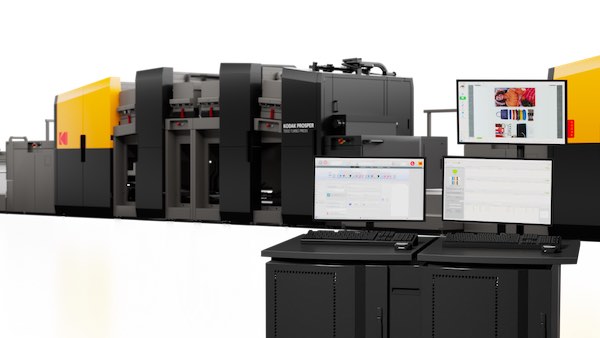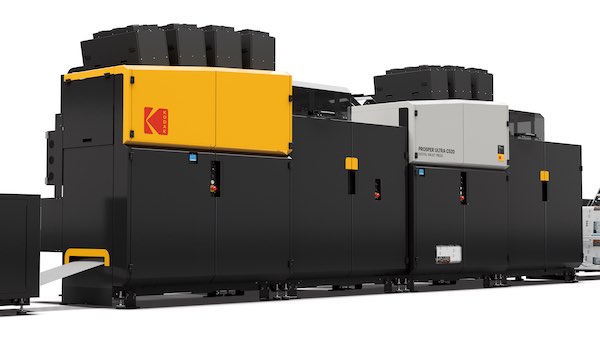For offset printing companies thinking about whether an inkjet investment makes sense for them it often comes down to a discussion of whether inkjet technology could supplement, complement, or replace existing offset equipment. In this article we’ll look at those perspectives as distinct inkjet strategies:
- Supplement: Using inkjet to enter new market segments, deliver new capabilities that their current press technology does not, or both. This might enable a new, lower volume application area to be ramped up until volumes are cost effective for offset, or there may be demand for new capabilities with existing customers such as small batch on demand production or full personalization.
- Complement: Inkjet technology can also be used side-by-side with existing processes to perform parts of a printed product or parts of the production volume for a particular product. For example, short-run book blocks might be printed most cost effectively on inkjet, with toner the chosen process for book covers. In higher volume, the same book bodies might be printed on an offset press. Some printed pieces may be made up of high-volume components printed on offset with personalized or versioned components produced on inkjet.
- Replace: Faced with shrinking order sizes, growing demand for personalization, and dramatic advances in inkjet speed and image quality, many companies may think about replacing offset equipment altogether. Even companies using toner, including those with fully depreciated equipment, are finding economic incentives to transition to inkjet.
While we will discuss these strategies individually, quite often a company is interested in two or more of these outcomes. There are often opportunities to replace some technology while complementing other processes and inkjet almost always provides new capabilities.
Strategic Impact on Inkjet Evaluation
In many ways, a replacement strategy is the most straightforward. You are looking at an economic justification relative to existing equipment with known costs and volumes. However, even if existing presses are being replaced, you will want to consider whether you will replace related feeding and finishing or if your new equipment will need to be compatible. Compatibility may not be immediately evident if moving from sheet to roll or vice versa.
When investing in complementary press technology, you have all the considerations of a replacement strategy plus you need to consider:
- How to manage color and quality consistency across processes.
- Cost and price management for mixed process pieces.
- Estimating and operational guidelines for determining where a job runs.
When you already have an equipment fleet in place, your customer’s priorities for different factors will also influence how you estimate jobs and on what equipment you decide to run it.
For example, it may be more economical to run a direct mail job on offset and add variable data as a second pass but if time-to-market is a priority printing the job on an inkjet press may be the best choice despite a higher unit cost.
Evaluating inkjet to supplement your existing equipment may seem more straight-forward than the replacement or complement scenarios, but there can be significantly more unknowns. If you are intending to use the press for a new type of business, you may not fully understand the requirements. If it is the first time investing in inkjet, there is a learning curve there as well. Inkjet presses are highly diverse in terms of speed, media compatibility, format, running cost, image quality and color gamut. Selecting a press that uses an unknown process to serve an unfamiliar market or application segment can be challenging. Understanding how to integrate new technology into your operation can be daunting.
The Kodak Inkjet Strategy
“We recognize that every printing company is different,” says Andrea Connor, Kodak Worldwide Solutions Marketing Manager, Digital Print. “We work with companies who use offset, electrophotography, inkjet, and hybrid presses and know that there is not a single solution that is best for everyone. Our goal is to understand a customer’s needs and then provide a highly configurable set of options and clear guidance to help customers find the right fit for their inkjet strategy.”
Putting this in context, Kodak derives considerably more of their revenue from supporting offset environments than they do from selling or supporting inkjet presses but they recognize that inkjet is the future. From commercial print to publishing to packaging, they offer a configurable platform of inkjet components and complete press options that allow companies to develop their inkjet portfolio in a rational way.
Of key importance is Kodak’s focus on providing software solutions that allow companies to integrate their press technology across processes and across suppliers. The Kodak PRINERGY Platform provides a single, integrated workflow solution that unites production across offset, flexo, gravure, electrophotography, and inkjet. This enables central management of jobs using an intuitive interface to create, submit, manage and quality control jobs.
PRINERGY is widely used to drive computer-to-plate (CTP) equipment as well as in operations using a diverse array of digital printing technology including Canon, HP, Landa, Konica Minolta, Komori, Ricoh, Xerox and, naturally, Kodak. Compatibility is not limited to hardware; PRINERGY also simplifies automation through easy integration with a host of 3rd party software which can dramatically simplify the integration of new press technology into an operation.
Connor said, “It's notable that, for decades, many companies have made their first foray into inkjet and personalization with a complementary strategy that adds Kodak printheads to existing analog equipment.” This is an approach that Kodak continues to support and grow with their PROSPER Plus and S series of imprinting systems. These tools allow monochrome or color inkjet overprinting capabilities to be added to offset, flexo and gravure printers without slowing down production or changing finishing options. This option drives significant value but does not enable the level of flexibility and personalization offered by a fully digital inkjet solution.
For companies ready to invest in a press, Kodak offers options to supplement, complement or replace existing technologies. First let’s take a high-level look at the Kodak inkjet portfolio followed by some examples of how the presses support different strategies and priorities. Note that Kodak’s portfolio of web-fed, CMYK inkjet presses relies on its STREAM and ULTRASTREAM continuous inkjet head technology which I wrote about previously in “Take a Closer Look at Continuous Inkjet.”
PROSPER
The PROSPER 7000 Turbo Press and PROSPER 6000 Presses use STREAM printheads and can print on 42-270 gsm paper, 28# newsprint to 100# cover, uncoated free sheet groundwood and matte, glossy, and silk coated papers.
- The 6000 series offers three models that operate at up to 4,106 A4/3,861 US letter pages per minute (ppm), at a maximum resolution of 175 lpi (600 x 900 dpi) supporting an average monthly volume of up to 126 million pages.
- The newer PROSPER 7000 Turbo is currently world’s fastest inkjet press. It prints up to 5,523 A4/5,194 US letter ppm with a resolution of 85-100 lpi (600 x 450 dpi) at top speed and up to 175 lpi (600 x 900 dpi) at reduced speed with a duty cycle of over 200 million pages per month.

Kodak PROSPER 7000 Turbo
PROSPER ULTRA
The PROSPER ULTRA 520 series uses ULTRASTREAM heads to deliver 200 lpi (600 x 1800 dpi) at up to 2,020 A4/2,148 US letter images per minute on media weights ranging from 45 to 270 gsm. The PROSPER ULTRA 520 Press is unique in its ability to print its highest resolution at its full speed, even for print applications requiring glossy paper with heavy ink coverage. The duty cycle is rated at up to 62.4 million pages per month. There are two models on offer, the ULTRA C520 optimized for high ink coverage applications and the lower cost P520 version for applications with medium and lower ink requirements.

PROSPER ULTRA C520
Finding the Right Fit
Ultimately, an inkjet evaluation will be most dependent on the type of work being produced and the inherent requirements for ink coverage, color matching, image quality, fine text legibility, variability, speed, substrate compatibility and price sensitivity of the end customer. As I wrote previously in “Debunking Definitive Crossover Claims,” the cadence, uniformity and overall volume of print jobs, taken together, also have a major influence on press suitability.
Replace, Complement, Supplement
A company seeking to replace their web offset presses might lean toward the PROSPER 7000 Turbo as it offers the highest speed/quality combination available with offset gloss coated stock compatibility.
However, a company moving from a sheet-fed offset environment might place color and quality requirements above speed. Kodak reports that the PROSPER ULTRA C520 press can deliver a color gamut 1.4 times larger than GRACoL or FOGRA color spaces for more accurate color-matching.
A similar tradeoff between highest speed versus highest color and coverage might be important when considering a press to complement an existing offset environment as well. A preference for close matching of output inkjet and offset processes may take precedence if output from both processes will be combined in a single piece such as a magazine, catalog, or other mailer. In other cases, where output will not be compared side-by-side, speed may take precedence. We have also seen companies moving lower volume forms and book work to monochrome inkjet as a complement to offset for high-volume jobs. There are configurations of both the PROSPER and PROSPER ULTRA series to meet these needs.
Companies who want to use inkjet to supplement their business by moving into new markets will, of course, base their decisions on the needs of the new applications. Even if other features are a match, it is rare to see a company invest in a press with a duty cycle of over 200 million images per month like the PROSPER 7000 Turbo for a purely supplemental strategy. However, such an investment is not out of the question if the sales funnel has been developed in advance of an inkjet acquisition. A more likely fit would be a press in the ULTRA 520 series configured for the ink coverage requirements of the target application set.
Kodak has seen these strategies embraced, together and separately, to drive growth and efficiency for their customers. Connor says, “Our PROSPER 7000 Turbo and 6000 presses are a great fit for book and publication printers, as well as commercial and direct mail printers, with 50 million pages on offset or a combination of roll-fed and sheet-fed digital presses and offset. The ability to customize the PROSPER 7000 Turbo with three print modes means the press is optimized for the production needs of each project at each print shop.”
The PROSPER ULTRA 520 press can dramatically drive down costs for companies producing high coverage work on toner presses or trying to support shrinking run lengths on offset equipment. Even companies who have already invested in other inkjet equipment may welcome the opportunity to move into new markets, drive down running costs or to drive greater coverage onto a wider array of media.
“We believe that our range of press solutions along with our software portfolio can support customers growth plans while enabling compatibility with existing offset and toner operations,” said Connor. “No two print businesses are alike so our strategy must be as flexible and forward-thinking as our customer’s.”















Discussion
Only verified members can comment.